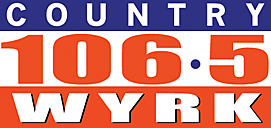![Robotic Dairy Farming in Western New York on the Rise [PHOTOS/VIDEO]](http://townsquare.media/site/10/files/2016/02/DSCN07971.jpg?w=630&h=420&zc=1&s=0&a=t&q=89&w=980&q=75)
Robotic Dairy Farming in Western New York on the Rise [PHOTOS/VIDEO]
The amount farms in New York State (and nationwide) is fading. Those that can withstand the hardships of slumping demand and higher operating costs have learned to adapt or find other ways to stay productive or more importantly, efficient.
The dairy farming industry in New York has seen a steady decline over the last few years and farmers were put on edge when production at the Muller Quaker Dairy plant in Batavia ceased last December.
Advances In Technology
George Haier, of George Haier Dairy, is one of the Western New York Farmers that have had to become more efficient in order to stay ahead of the roller coaster that is the dairy industry. I stopped by Haier's place on Route 75 to see the technology that he installed to help him stay profitable.
George Haier was first in Erie County to install a robotic milking system. Over the last few years, other farms have purchased the automated system as well. Some of the larger farms even have multiple robots. The DeLaval product allows farmers like Haier to milk around the clock with minimal human interaction. As a matter of fact, the system will call Haier on his cell phone when there is an issue while he is off doing other things. "I'll be out on my snowmobile somewhere and the system will call if I need to get back for any reason," Haier told me.
Haier is no rookie in the dairy industry. He has been farming on his family farm in North Collins since 1984 and decided to become more advanced in August of 2012 when he had his single robotic milking stall placed in his parlor. "The economy is tough on dairy farms. We need demand to go up," Haier explained. He was pretty blunt when he continued "I hate to say it, but some of the smaller farms may have to fold or stop production if things don't turn around."
Industry In Decline
The numbers are there to back his assertion. Just a year ago, the price per 100 pounds of milk was around $25. At last check, that was nearly cut in half to around $14 this year. With less money coming back to farms, the tighter they have to buckle the proverbial financial belt. That can mean selling off equipment and land but mostly means having to let go of full time employees.
Bovine Spa?
Haier's cows are very well taken care of. There is even an automatic back scratcher in the holding area. Combined with soft bedding and plenty of food and water, it is like bovine spa! The cows even get so acclimated, they seem to know when it's their turn in rotation.
To say that the system is smart would be an understatement. The robot inspects each cow for any sort of imperfections, can tell how many pounds each cow averages individually, and twice a day the robot will sanitize itself to ensure it stays free of any harmful bacteria.
George Haier has hosted a few open houses at his farm to explain how the robotic system works. "I've had guys come from other states, hundreds of miles away to check it out when I first put it in," said Haier.
Costs Outweigh Income?
Robotic milking systems have their pros and cons. Yes, they allow for around the clock milking, added efficiency and minimal human interaction. However, the start up costs and monthly maintenance costs may outweigh the benefits in some cases. According to Haier "It's around $1,000 per month" to maintain the robot he has.
After a few minutes of watching the process, I could tell how the advances in technology are raising the bar and competition in the agriculture industry. Each of his 60-65 cows that rotate through the parlor every day are milked multiple times each day, approximately 305 days per year (figuring in that there is roughly 60 days between calves). George Haier's robot and cows are averaging 5,000 pounds of milk per day. Milk weighs around 8.6 pounds per gallon for a total of 581 gallons of milk per day.
At first glance, even $14 per 100 pounds, can seem to be pretty lucrative annually for a small to medium sized farm. However, that's before the overhead of farming is factored in to the equation.
The good news for small farms (at least these days) is that fuel prices have gone down considerably over the last months. The price of essentials like equipment, fertilizers, feed and utilities have not matched that decline.Even though technology is helping to improve the manner and efficiency of farming, the main issue smaller farms face will continue to be the need for demand to increase.
More From 106.5 WYRK

![The 8 Most Infamous Mafia Crime Family Bosses in Buffalo [List]](http://townsquare.media/site/11/files/2016/05/Mafia-Keystone-via-Getty-Images.jpg?w=980&q=75)

![The 6 Most Infamous Serial Killers From Buffalo and WNY! [List]](http://townsquare.media/site/11/files/2016/03/Police-Tape.jpg?w=980&q=75)
![5 Places That The Rest of America Wants From Buffalo [LIST]](http://townsquare.media/site/10/files/2019/10/RS9901_100538196.jpg?w=980&q=75)


![Who Has Played at Darien Lake the Most Times? [LIST]](http://townsquare.media/site/16/files/2016/03/Darien-Lake-Rob-Banks.jpg?w=980&q=75)

